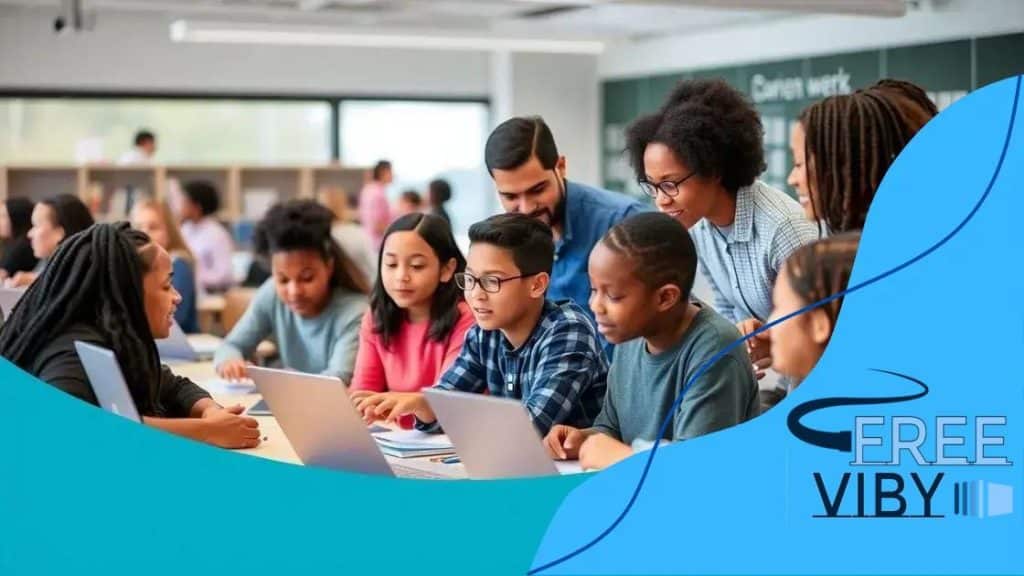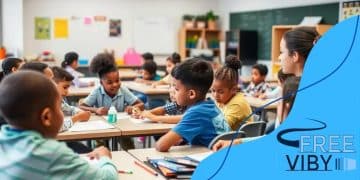Executive orders push school reforms for better education

Anúncios
Executive orders push school reforms by implementing policies that enhance personalized learning, integrate technology, and foster community involvement, ultimately improving educational outcomes for students.
Executive orders push school reforms in various states, bringing significant changes to the education landscape. Have you ever wondered how these directives shape the future of schooling? Let’s dive into the details and see what this means for our students.
Anúncios
Understanding the impact of executive orders
Understanding executive orders is crucial as they shape policies that affect our schools. These orders often aim to improve educational systems, making them more equitable and effective. In recent discussions, it has become clear that the impact of executive orders extends beyond mere legislation; they influence the daily experiences of students and teachers.
What are executive orders?
Executive orders are directives issued by the President of the United States to manage the operations of the federal government. They are particularly significant in the context of education reform, as they can set important agendas.
Benefits of executive orders in education
When implemented thoughtfully, these orders can lead to positive reforms in schools. For instance, they can prioritize funding for underserved communities and ensure adequate resources for all students. Here are some of the benefits:
Anúncios
- Increased focus on equity in education.
- Streamlined processes for applying education grants.
- Enhanced collaboration between state and local education agencies.
Moreover, when states adopt these orders, they often reflect the unique needs of their communities, adjusting educational frameworks to better serve students. These changes can make learning more accessible and engaging.
However, the feelings surrounding executive orders are mixed. While many educators welcome the changes that these reforms bring, others express concerns about their implementation. Key stakeholders, including teachers, parents, and community leaders, often engage in discussions to address these concerns and advocate for the most effective practices.
As we delve deeper into the implications of executive orders, it’s essential to recognize that their impact is not just legislative but also emotional. Schools are the heart of our communities, and changes to their operations can lead to significant shifts in the educational landscape.
Key examples of school reform initiatives
When discussing school reform initiatives, it’s essential to highlight key examples that have made significant impacts. These initiatives often serve as models for other districts and states, showing how change is possible. Some notable examples illustrate how executive orders influence education positively.
Fundings for high-quality early education
One effective approach is the emphasis on funding for early childhood education. Programs such as Pre-K expansion have gained momentum through state executive orders. By prioritizing early learning, these initiatives aim to set students on a path for success right from the start.
Implementing STEM programs
Another vital example is the implementation of comprehensive STEM (Science, Technology, Engineering, and Mathematics) programs. Many states have adopted reform initiatives that focus on enhancing STEM education. This shift encourages students to engage in critical thinking and problem-solving skills that are essential in today’s job market.
- Partnerships with local businesses to create internship opportunities.
- Development of hands-on learning experiences.
- Training teachers in innovative teaching methods.
Additionally, initiatives often focus on increasing diversity in the classroom. This is essential for fostering an environment where all students can thrive. Programs aimed at recruiting a diverse teacher workforce help students see themselves represented in their educators.
Integration of technology in classrooms
Another significant reform is the integration of technology in classrooms. As schools transition to digital resources, executive orders often support this shift by providing necessary funding. This initiative allows students access to the latest tools and fosters collaboration among peers.
Ultimately, these examples of school reform initiatives reflect the ongoing evolution of educational systems. By focusing on impactful changes, executive orders can create lasting improvements that benefit students across the nation. They remind us that education is a shared responsibility, and the path to reform involves active participation from all stakeholders.
Challenges faced by education stakeholders

Education stakeholders face numerous challenges while navigating the complexities of school reforms. Understanding these challenges is essential to finding ways to overcome them. Groups such as teachers, administrators, parents, and students all have unique perspectives and concerns.Policy changes can often create uncertainty, as stakeholders adapt to new expectations and guidelines.
Resistance to change
One of the main challenges is resistance to change. Many educators and parents may feel anxious about new approaches and policies. This resistance can hinder progress and implementation of initiatives that aim to improve education. There are several reasons behind this resistance:
- Fear of the unknown regarding how reforms will impact existing practices.
- Concerns about the effectiveness of new methods compared to traditional approaches.
- Emotional investment in long-standing educational practices.
Communication also plays a vital role in overcoming resistance. Open dialogues between stakeholders can help clarify intentions behind reforms and demonstrate their potential benefits.
Funding and resource allocation
Another significant challenge education stakeholders face is securing adequate funding. Many reform initiatives require financial support to succeed, and budget constraints can limit their effectiveness. When funding is insufficient, schools struggle to provide necessary resources such as technology and training for educators.
Stakeholders must advocate for proper funding and resource allocation to implement reforms effectively. By focusing on data-driven outcomes, they can demonstrate the value of investing in education.
Balancing diverse needs
Each stakeholder group has different priorities, creating the difficulty of balancing diverse needs. For example, parents may prioritize academic performance, while teachers may focus on classroom management, and students might want more engaging learning experiences. Addressing all these concerns can be complex.
Engaging all groups in discussions about reforms can lead to collaborative solutions. When stakeholders work together, they can address varying needs more effectively, leading to a more inclusive approach to education reform.
The role of community in educational change
The community plays a vital role in educational change, influencing the success of reform initiatives. By involving parents, local businesses, and organizations, schools can create a stronger support network that enhances the learning experience for students. When communities actively participate in education, they help to shape policies and practices that align with their unique needs.
Community engagement in schools
One essential aspect is community engagement. Schools that foster relationships with their communities often see improved outcomes. Engaged communities can provide resources, mentorship, and opportunities for collaboration. These connections create a supportive environment where students feel valued and motivated.
Benefits of local partnerships
Forming partnerships with local businesses and organizations is another important component of educational change. These partnerships can:
- Offer internships and real-world experiences for students.
- Provide funding and resources for school programs.
- Create mentorship opportunities with professionals in various fields.
By building these connections, schools can enhance their programs and ensure that they are relevant to the needs of the local economy.
Advocacy from community members
Community members can also act as advocates for educational reform. When parents, teachers, and local leaders come together, they can voice their concerns and support for specific initiatives. This advocacy can lead to increased awareness and action regarding the needs of schools, leading to changes that benefit students.
In this collaborative atmosphere, individuals feel empowered to participate in decisions that affect their education system. As a result, schools that embrace community involvement often tailor their programs to address local challenges effectively.
Overall, the role of community in educational change is critical. By working together, communities and schools can create an environment where every student has the opportunity to succeed. This collaboration not only benefits students but also strengthens the community as a whole.
Future trends in school reform policies
As we look at the horizon of education, it’s essential to explore future trends in school reform policies. With the landscape of education continuously changing, these trends are shaping how schools operate and engage students. Innovations in technology, teaching methods, and policy reforms are setting the stage for a new era in education.
Emphasis on personalized learning
One of the prominent trends is the growing emphasis on personalized learning. Schools are moving toward customized educational experiences that address individual student needs. This approach ensures that learning is more tailored, allowing students to progress at their own pace and explore their interests.
Increased integration of technology
The integration of technology into classrooms is another key trend. Schools are adopting digital tools that enhance learning and engagement. These technologies can include:
- Online learning platforms that offer flexible learning schedules.
- Virtual reality for immersive educational experiences.
- Data analytics to track student progress and tailor assignments.
By leveraging technology, educators can provide more interactive and effective learning environments.
Focus on social-emotional learning
Another critical area is the focus on social-emotional learning (SEL). This trend emphasizes the importance of developing students’ emotional intelligence and interpersonal skills. Schools are incorporating SEL into their curricula, teaching students valuable skills such as empathy, conflict resolution, and collaboration.
This growing awareness of student well-being supports academic success and helps cultivate a positive school environment. As schools implement SEL programs, they create supportive communities that care for the whole child, not just their academic performance.
Overall, the future of school reform policies includes exciting trends that prioritize personalized learning, technological integration, and social-emotional development. These changes are pivotal in preparing students for success in an ever-evolving world.
FAQ – Frequently Asked Questions about Executive Orders and School Reforms
What are executive orders and how do they impact education?
Executive orders are directives from the President that influence education policy and reforms, aiming for improvements in school systems and practices.
How does personalized learning benefit students?
Personalized learning tailors educational experiences to meet individual needs, helping students learn at their own pace and explore their interests.
What role does technology play in modern education?
Technology enhances learning by providing digital tools that facilitate engagement, collaboration, and access to resources in the classroom.
Why is community involvement important in education reforms?
Community involvement creates stronger support networks, ensuring reforms address local needs and helping to bridge gaps between schools and families.






